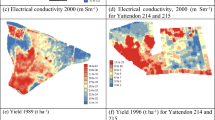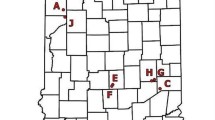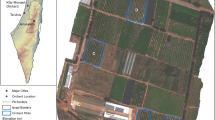Abstract
In the U.S.A. intensive grid soil sampling has conventionally been used to develop prescription maps for variable rate (VRT) fertilizer application. Grid sampling can provide an accurate basis for variable rate application; however the cost and labor requirements suggest other approaches may be more economical. This research was initiated to determine if farmer-developed management zone maps based on soil color from aerial photographs, topography, and the farmer's past management experience can be effective in developing variable rate application maps. The accuracy of farmer-developed management zone maps was investigated on two center pivot irrigated fields near Wiggins, Colorado. Using aerial photographs as a template, the farmer defined high, medium, and low productivity management zones. Cluster analysis confirmed that management zones represent different suites of soil characteristics. In field one, soil organic matter (SOM), clay, nitrate, potassium, zinc, conductivity and corn yield data followed the trends indicated by the management zones. In field two, however, the medium productivity zone had the highest values for these parameters. Farmer developed management zones appear to be effective in identifying different management zones; however, ground truthing is needed to develop accurate VRT maps from the zones.
Similar content being viewed by others
References
A. U. Bhatti, D. J. Mulla, and B. E. Frazier, Estimation of soil properties and wheat yields on complex eroded hills using geostatistics and thematic mapper images. Remote Sensing the Environment 37, 181-191 (1991).
C. D. Bohham and R. M. Reich, Influence of spatial autocorrelation on a fixed-effect model used to evaluate treatment of oil spills. Applied Mathematics and Computation 106, 149-162 (1999).
P. M. Carr, G. R. Carlson, J. S. Jacobsen, G. A. Nielsen, and E. O. Skogley, Farming soils, not fields: a strategy for increasing fertilizer profitability. Journal of Production Agriculture 4, 57-61 (1991).
F. Chen, D. E. Kissel, L. T. West, and W. Adkins, Field-scale mapping of surface soil organic carbon using remotely sensed imagery. Soil Science Society of America Journal 64, 746-753 (2000).
R. K. Crookston, Using decision cases to enhance technology transfer in precision agriculture. In: Proceedings of the 3rd International Conference on Site-Specific Management for Agricultural Systems, <nt>edited by</nt> P. C. Robert, R. H. Rust, and W. E. Larson (ASA/CSSA/SSSA, Madison, WI, USA, 1996), pp. 1117-122.
T. Doerge, Defining management zones for precision farming. Crop Insight 8, 21, (1999), Pioneer Hybrids.
R. B. Ferguson, C. A. Gotway, G. W. Hergert, and T. A. Peterson, Soil sampling for site-specific nitrogen management. In: Proceedings of the 3rd International Conference on Site-Specific Management for Agricultural Systems, <nt>edited by</nt> P. C. Robert, R. H. Rust, and W. E. Larson (ASA/CSSA/SSSA, Madison, WI, USA, 1996), pp. 13-22.
T. E. Fiez, B. C. Miller, and W. L. Pan, Assessment of spatially variable nitrogen fertilizer management in winter wheat. Journal of Production Agriculture 7, 86-93 (1994).
K. L. Fleming, D. G. Westfall, D. F. Heermann, D. B. Bosley, F. B. Peairs, and P. Westra, Precision farming: from technology to decisions, a case study. In: Proceedings of the 4th International Conference on Site-Specific Management for Agricultural Systems, <nt>edited by</nt> P. C. Robert, R. H. Rust, and W. E. Larson (ASA/CSSA/SSSA, Madison, WI, USA, 1998), p. 1777-1783.
D. W. Franzen and T. R. Peck, Sampling for site specific management. In: Proceedings of the 2nd International Conference on Site-Specific Management for Agricultural Systems, <nt>edited by</nt> P. C. Robert, R. H. Rust, and W. E. Larson (ASA/CSSA/SSSA, Madison, WI, USA, 1994), pp. 535-551.
C. A. Gotway, R. B. Ferguson, and G. W. Hergert, The effects of mapping scale on variable rate fertilizer recommendations for corn. In: Proceedings of the 3rd International Conference on Site-Specific Management for Agricultural Systems, <nt>edited by</nt> P. C. Robert, R. H. Rust, and W. E. Larson (ASA/CSSA/SSSA, Madison, WI, USA, 1996), p. 321-330.
M. W. Hammond, Cost analysis of variable fertility management of phosphorus and potassium for potato production in central Washington. In: Soil Specific Crop Management, <nt>edited by</nt> P. C. Robert, R. H. Rust, and W. E. Larson (ASA/CSSA/SSSA, Madison, WI, USA, 1992), p. 213-228.
A. L. Jones, L. N. Meile, C. A. Bartles, and C. A. Miller, Relationship of landscape position and properties to crop production. Journal of Soil Water Conservation 44, 328-332 (1989).
R. G. Kachanoski, E. G. Gregorich, and I. J. Van Wesenbeck, Estimating spatial variations of soil water content using noncontacting electromagnetic inductive methods. Canadian Journal of Soil Science 68, 715-722 (1988).
N. R. Kitchen, K. A. Sudduth, and S. T. Drummond, Soil electrical conductivity as a crop productivity measure for clay pan soils. Journal of Production Agriculture 12, 607-617 (1999).
A. N. Kravchenko and D. G. Bullock, Comparison of interpolation methods for mapping soil P and K contents. In: Proceedings of the 4th International Conference on Site-Specific Management for AgriculŽ tural Systems, <nt>edited by</nt> P. C. Robert, R. H. Rust, and W. E. Larson (ASA/CSSA/SSSA, Madison, WI, USA, 1998) ), p. 19.
E. D. Lund, C. D. Christy, and P. E. Drummond, Practical applications of soil electrical conductivity mapping. In: Precision Agriculture '99, Proceedings of the 2nd European Conference on Precision Agriculture, <nt>edited by</nt> J. V. Stafford BIOS Scientific Publishers, Oxford, UK, (1999), pp. 771-779.
Mathsoft, S-PLUS guide to statistical and mathematical analysis. Ver. 3.3, Seattle, Washington (1995).
M. J. Mausbach, D. J. Lytle, and L. D. Spevey, Application of soil survey information to soil specific farming. In: Proceedings of the 3rd International Conference on Site-Specific Management for AgriculŽ tural Systems, <nt>edited by</nt> P. C. Robert, R. H. Rust, and W. E. Larson (ASA/CSSA/SSSA, Madison, WI, USA, 1993), pp. 57-68.
A. B. McBratney and M. J. Pringle, Estimating average and proportional variograms of soil properties and their potential use in precision agriculture. Precision Agriculture 1, 219-236 (1999).
R. A. McBride, A. M. Gordon, and S. C. Shrive, Estimating forest soil quality from terrain measurements of apparent electrical conductivity. Soil Science Society of America Journal 54, 290-293 (1990).
B. L. McCann, D. J. Pennick, C. van Kessel, and F. L. Walley, The development of management units for site-specific farming. In: Proceedings of the 3rd International Conference on Site-Specific Management for Agricultural Systems, <nt>edited by</nt> P. C. Robert, R. H. Rust, and W. E. Larson (ASA/CSSA/SSSA, Madison, WI, USA, 1996), pp. 295-302.
P. A. P. Moran, Notes on continuous stochastic phenomena. Biometrica 37, 17-23 (1950).
R. A. Ortega, D. G. Westfall, and G. A. Peterson, Variability of phosphorus over landscapes and dryland winter wheat yields. Better Crops with Plant Food, No. 2 Published by the Potash and Phosphorus Institute, (1997).
J. D. Rhoades and D. L. Corwin, Determining soil electrical conductivity-depth relations using an inductive electromagnetic soil conductivity meter. Soil Science Society of America Journal 45, 225-260 (1981).
SAS Institute, SAS-STAT User's Guide, Ver. 6, 4th ed. Cary, NC, (1990).
J. E. Sawyer, Concepts of variable rate technology with consideration for fertilizer application. Journal of Production Agriculture 7, 195-201 (1994).
Soil Survey Staff, Keys to Soil Taxonomy, 7th ed. USDA-NRCS, 1996.
R. G. Spomer and R. F. Piest, Soil productivity and erosion of Iowa loess soils. Transactions of the American Society of Agricultural Engineers 25, 1295-1299 (1982).
B. M. Whelan, A. B. McBratney, and R. A. Viscarra Rossel, Spatial prediction for precision farming. In: Proceedings of the 3rd International Conference on Site-Specific Management for Agricultural Systems, <nt>edited by</nt> P. C. Robert, R. H. Rust, and W. E. Larson (ASA/CSSA/SSSA, Madison, WI, USA, 1996), pp. 331-342.
B. G. Williams and D. Hoey, The use of electromagnetic induction to detect the spatial variability of the salt and clay content of soils. Australian Journal of Soil Research 25, 21-27 (1987).
Author information
Authors and Affiliations
Rights and permissions
About this article
Cite this article
Fleming, K.L., Westfall, D.G., Wiens, D.W. et al. Evaluating Farmer Defined Management Zone Maps for Variable Rate Fertilizer Application. Precision Agriculture 2, 201–215 (2000). https://doi.org/10.1023/A:1011481832064
Issue Date:
DOI: https://doi.org/10.1023/A:1011481832064




